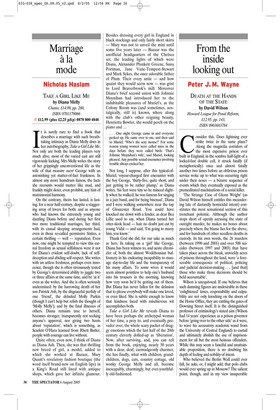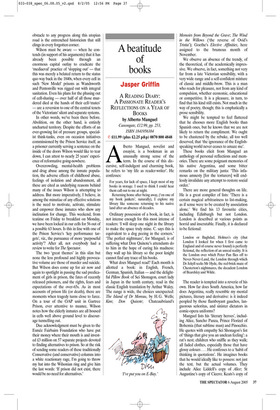From the inside looking out
Peter J. M. Wayne
DEATH AT THE HANDS OF THE STATE by David Wilson Howard League for Penal Reform, £12.95, pp. 143, ISBN 0903683784 Consider this. Does lightning ever strike twice in the same place? Along the magnolia corridors of the most expensive prison ever built in England, in the sombre half-light of a locked-fast double cell, it struck fatally (if metaphorically) once and almost fatally another two times before an oblivious prison service woke up to what was occurring right under their noses — a bizarre sequence of events which they eventually exposed as the premeditated machinations of a serial killer.
‘The Strange Case of Glenn Wright’ (as David Wilson himself entitles this meandering tale of dastardly homicidal intent) constitutes the most sensational section of this trenchant polemic. Although the author stops short of openly accusing the state of outright murder, he makes no bones about precisely where the blame lies for the above, and for hundreds of other needless deaths in custody. In his own words, the 26 murders (between 1990 and 2001) and over 500 suicides (between 1997 and 2003) that have taken place across the bleak, unwieldy acres of prisons throughout the land, were ‘a foreseeable consequence of political, policing and judicial decision-making ... [and that] those who make those decisions should be held accountable’.
Wilson is unequivocal. If one believes that such damning figures are undesirable in these ‘enlightened’ times, responsibility and culpability are not only knocking on the doors of the Home Office, they are rattling the gates of Downing Street itself. It is the distinguished professor of criminology’s stated aim (Wilson had 14 years’ experience as a prison governor before ‘going over to the other side’ as it were, to wave his accusatory academic wand from the University of Central England) to curtail and ultimately abolish the use of imprisonment for all but the most heinous offenders. While this may seem a fanciful and unattainable proposition, there is no doubting his depth of feeling and nobility of intent.
Who believed the Berlin Wall could ever fall, he asks, or, I might add, that polo clubs would ever spring up in Moscow? The salient point, though, and in my view insuperable obstacle to any progress along this utopian road is the entrenched historicism that still clings in every forgotten corner.
Wilson must be aware — when he contends (in support of his arguments) that it has already been possible through an enormous capital outlay to eradicate the ‘mediaeval’ practice of ‘slopping out’ — that this was merely a belated return to the status quo way back in the 1840s, when every cell in such ‘New Model’ prisons as Wandsworth and Pentonville was rigged out with integral sanitation. Even his plans for the phasing out of cell-sharing — over half of all those murdered died at the hands of their cell-‘mates’ — are a reversion to one of the central tenets of the Victorians’ silent and separate systems.
In other words, we’ve been there before. Abolition, on the other hand, is entirely uncharted territory. Despite the efforts of an ever-growing list of pressure groups, specialist think-tanks, even on occasion initiatives commissioned by the Prison Service itself, as a prisoner currently serving a sentence on the inside of the doors Wilson would like to tear down, I can attest to nearly 25 years’ experience of reformative going-nowhere.
Overcrowding, mental-health problems and drug abuse among the inmate population, the adverse effects of childhood abuse, feelings of isolation and abandonment, all these are cited as underlying reasons behind many of the issues Wilson is attempting to address. But more imperatively, I believe, in among the minutiae of any effective solutions is the need to motivate, activate, stimulate and empower those inmates who show any inclination for change. This weekend, from teatime on Friday to breakfast on Monday, we have been locked in our cells for 56 out of a possible 63 hours. Is this in line with one of the Prison Service’s ‘key performance targets’, viz., the pursuance of more ‘purposeful activity’? After all, not everybody had a review to write for The Spectator.
The two ‘great themes’ in this slim but none the less profound and highly provocative volume are those of murder and suicide. But Wilson does come up for air now and again to spotlight in passing the sad predicament of girls in prison, the fates of recently released prisoners, and the rights, fears and expectations of the over-65s. As in most accounts of prison life (or death), there are moments when tragedy turns close to farce. On a tour of the OAP unit in Gartree Prison, ever attentive to nuance, Wilson notes how the elderly inmates are all housed in cells well above ground level to discourage tunnelling out.
Due acknowledgment must be given to the Esmée Fairbairn Foundation who have put their money where their mouth is and invested £3 million on 57 separate projects devoted to finding alternatives to prison. So at the risk of sending some readers of these traditionally Conservative (and conservative) columns into a white reactionary rage, I’m going to throw my hat into the Wilsonian ring and give him the last words: ‘If prison did not exist, there would be no need for alternatives.’












































 Previous page
Previous page